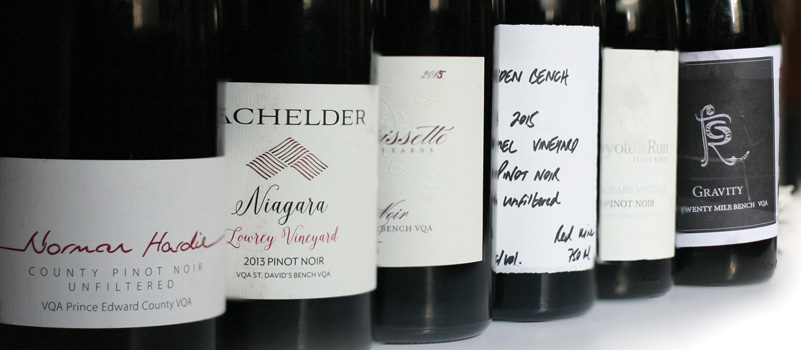Four teams compete to find the most site-expressive North American pinot noir
Pinot noir didn’t mean much to American wine drinkers until the early 2000s. Some, perhaps, knew it as the grape responsible for red Burgundy. Others might have been familiar with the pinot noirs from Hanzell, Calera, Au Bon Climat, Eyrie and Williams Selyem—some of the grape’s early American standard-bearers. But it wasn’t until the past decade that interest in pinot noir really exploded, driving a feverish planting boom. Now, there’s a lot being grown on our shores, some of it pretty great.
This year, twelve sommeliers joined in the Sommelier Scavenger Hunt. Each team of three chose a region, visiting fields and cellars to find pinot noirs with unmistakable terroir character.


Michael Madrigale, Michelle Biscieglia and Josiah Baldivino first teamed up in 2014. After winning our inaugural Sommelier Scavenger Hunt with their selection of Napa Valley cabernet sauvignon, they repeated their win the following year with six compelling examples of grenache from McLaren Vale. This year, they took the road less travelled. “We chose the underdog,” says Madrigale. “Nobody in the States knows the wines of Ontario, but they deserve the spotlight.”


Six Essential Ontario Pinot Noirs
Norman Hardie 2013 Prince Edward County Unfiltered County Pinot Noir
“This is the coldest and furthest east area of Ontario,” Madrigale says, comparing the Trenton limestone and clay to the composite soil in Burgundy. “It’s 10.9 percent alcohol, with lots of saltiness, phenolic ripeness and high acidity.” With its mouthwatering precision, this was a favorite for a number of taste-off attendees.
Pearl Morissette 2015 Twenty Mile Bench Niagara Vineyards Pinot Noir
Heading to the Niagara Escarpment, Madrigale introduces François Morissette as “a Quebecois who comes from working many vintages in Burgundy for Freddy Mugnier and Jean-Marc Roulot. He is a bit of the natural wine flag-waver in Ontario: He adds no sulfur, no additives, and only ambient yeasts go into the fermentation.”
Bachelder 2013 St. David’s Bench Lowrey Vineyard Pinot Noir
“Lowrey Vineyard has the oldest plantings of pinot noir in the region,” Biscieglia explains, telling how Karl Keiser, the founder of Inniskillin, tried to convince growers to plant pinot noir. “The Lowrey family decided to plant in 1984—just five rows of pinot in clay loam and limestone soil. Thomas Bachelder’s wine is from those original five rows.”
Hidden Bench 2015 Rosomel Vineyard Unfiltered Pinot Noir
The team included this as a wine from dolomitic limestone, from the Beamsville Bench on the Niagara Escarpment. “Hidden Bench uses the Rosomel Vineyard for blending for aromatics, for the floral component. This is the first year when they’ve bottled it separately,” Biscieglia says.
Flat Rock 2015 Twenty Mile Bench Gravity Pinot Noir
“We have these benches, which are basically the slopes that come up from the lake,” Baldivino explains. Flat Rock grows on Twenty Mile Bench, where the soil is clay loam till over limestone. That, and the temperature-control system of Lake Ontario, is what this wine is all about, he says.
Coyote’s Run 2014 Four Mile Creek Rare Vintage Pinot Noir
“St. David’s Bench is really far from the lake, so here it’s a little bit warmer,” Baldivino says. “And it’s grown on clay soil, which is going to give you that riper, rounder feel.” Madrigale considers it the outlier in the flight: “The warmest wine and the one that uses oak as an ingredient.”
This story was featured in W&S April 2017.
Joshua Greene is the editor and publisher of Wine & Spirits magazine.
This story appears in the print issue of April 2017.
Like what you read? Subscribe today.
















